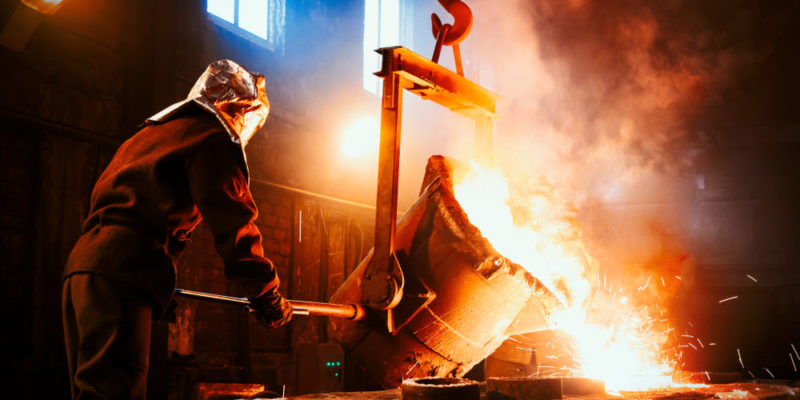We explain what is light and heavy industry and what are their differences. In addition, its main characteristics and how they are classified.
What is light and heavy industry?
Both light industry and heavy industry are, in principle, forms of industrial processing that require an initial supply of raw material to transform, through physical and chemical processes, into manufactured consumer goods (for the final consumer ) or semi-processed ( for subsequent industrial processes).
There are various ways of classifying the industrial exercise for its study and understanding in the face of an economic structure. The differences between light industry and heavy industry are based on the tonnage of raw material necessary to undertake production, as well as on the very dynamics through which said the operation will be carried out.
Light and Heavy Industry Features :
Manufactured goods

In general, the goods manufactured in the light industry already target the final consumer, since it uses partially processed materials. Think of the tobacco companies, for example, that receive the tobacco leaf and produce the packaged cigarette, ready for sale.
On the other hand, the heavy industry generates semi-processed materials that in turn serve as inputs to secondary industrial processes. For example, the iron industry extracts the ore and processes it into sheets that are later processed to produce objects and spare parts.
Required raw material
While heavy industry, focused on the extraction and/or physicochemical processing of certain raw materials, requires tons of elements and requires large doses of process elements (such as water and energy ), light industry is enough with a moderate injection of simpler materials.
Industrial site

As with raw materials, the requirements of heavy industry in terms of location and quantity of labor are much higher than those of light.
- Heavy industry. It requires a much more massive effort to deal with the large-scale transformation processes of the raw material, so it is usually located either in the vicinity of the source of extraction of the materials or near merchant ports where it can be received it.
- The light industry. It requires smaller facilities, less manpower, and fewer energy resources. Since its products are goods with a lot of added value, its preferential location is in the vicinity of the market, as close as possible to its final consumers.
Environmental impact
While the light industry is well tolerated in residential or commercial areas, heavy industry undertakes complex chemical processes that tend to have a very high impact on the environment, whether through solid waste, sewage, or the emission of gases.
Areas of occupation

The areas of interest for the light industry are practically endless. Every elaborate object of daily consumption comes from one of them. Even so, the preferred areas for this type of process are usually food and beverages, clothing and footwear, tobacco, textiles and the publishing sector.
Heavy industry, on the other hand, can be classified into four types according to their areas of occupation:
- The extractive industry. In direct relation to natural assets, it deals with the extraction of raw materials and their initial processing. It deals with the areas of mining, agriculture or wood and paper production.
- The cement industry. Dedicated to the transformation of different types of resources into lime and cement, essential for the construction sector.
- The steel industry. Avocada to intensive work with minerals, alloys and refinements, to produce a large number of intermediate goods: basic tools, metal plates, tubes, etc.
- The chemical industry. Dedicated to the handling of complex substances to obtain through specialized processes, a myriad of intermediate goods such as fuels, salts, acids, but also fertilizers, plastics, explosives, rubber, pharmaceuticals and also deals with petrochemical processes.
Global distribution
Although the favored areas for industrial development (especially heavy) point to territories with abundant resources , abundant labor and commercial extraction and transportation facilities, the industry is very unevenly distributed throughout the world.
The countries with the most complex industrial activity today are usually the countries that joined the global economic competition the fastest during the 19th and 20th centuries, reaching its highest points in the so-called first world: the US, Europe and Japan. , who concentrate almost 80% of the world’s industrial work.
To this must be added the recent emergence of Southeast Asia and the oil industry whose most abundant sites are the Middle East , Venezuela , Canada and Russia.
Participation in the local economy

Given that the natural market for heavy companies is other companies , their main concerns regarding the world economy tend to be related to variations in the price of raw materials and any secondary industrial expansion that may exist.
The light industry supports its market in the face of the consuming public , so it depends on internal consumption. That is the reason why they are the first to suffer the effects of the crises, because as consumption decreases, their activity slows down; which is then transmitted to heavy industry in a lower demand for raw materials.
Regarding the semi-heavy or equipment industry
The industrial explosion of the 20th century brought about the need for one more industrial form, known as semi-heavy or equipment industry , whose raw material is the semi-finished heavy goods and with them produces finished consumer goods.
However, these goods are not so much for the general public, but to be reinvested in industrial processes, such as sophisticated machinery and tools. It is a rapidly growing sector , given the technological revolution with which the 21st century has started its days.
Historical evolution

The light industry had its earliest appearance in the contemporary historical development , as it came into being a consumer society whose products satisfy demand.In fact, it preceded heavy production for a long time , whose appearance was subject to the development of tools, sciences and technologies that allowed the extraction and development of raw materials into more complex elements.
Challenges of today’s light and heavy industry
Facing a hypertechnologized landscape, the various types of industries require levels of specialization unprecedented in contemporary economic history, which in turn is facilitated by the development of automated, if not intelligent, machinery and tools. Something that also implies the need for a much more trained workforce.
Thus, the growth of the electronic industries has exploded at the rate of consumption of the latest generation technological goods, while the panorama of raw materials continues to fluctuate according to political , historical and social factors that do not seem to achieve stability.
The variation in oil prices , for example, has highlighted the dependence in the developed world on this non-renewable natural resource.
The above content published at Collaborative Research Group is for informational and educational purposes only and has been developed by referring to reliable sources and recommendations from technology experts. We do not have any contact with official entities nor do we intend to replace the information that they emit.














